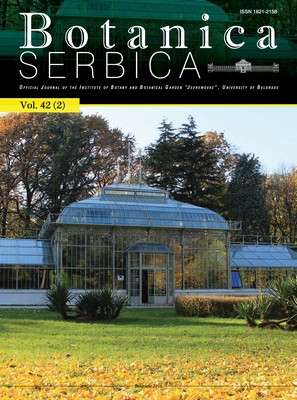
Volume 42 Issue 2 2018 |
Editor's Note - Botanica Serbica: Remembering the beginnings
|
Epiphytic bryophyte vegetation of the Samanl? Mountains (Sakarya-Kocaeli-Yalova-Bursa) in Northwest Turkey
|
KEY WORDS: association, bryophyte, epiphytic vegetation, life forms, life strategies, Samanl? Mountains, Turkey |
Checklist of Turkish bryophyte vegetation
|
KEY WORDS: bryophytes, bryosociology, checklist, Turkey, vegetation |
Effects of zinc and copper on development and survival of the moss Atrichum undulatum in controlled conditions
|
KEY WORDS: bryophytes, essential elements, growth, harmfulness, Atrichum undulatum |
Reproductive ecology of Allmania nodiflora, Celosia argentea var. margaritacea, and Digera muricata (Amaranthaceae)
|
KEY WORDS: anemochory, anemophily, entomophily, gynodioecy, hermaphroditism, hydrochory, myrmecochory |
Modelling the abundance of an endangered medicinal species, Phellodendron amurense: generalised linear model vs. generalised additive model
|
. KEY WORDS: species response, generalised linear model, generalised additive model, Phellodendron amurense, conservation |
Biological activities of Cretan Salvia pomifera extracts
|
KEY WORDS: antibacterial activity, anti-neurodegenerative activity, antioxidant activity, extracts, Salvia pomifera |
Chemical characterisation and antibacterial activity of the essential oil of wild Angelica seeds
|
KEY WORDS: Angelica sylvestris L., seeds, essential oil, chemical composition, antibacterial activity |
Bioactive extracts of Gentiana asclepiadea: antioxidant, antimicrobial, and antibiofilm activity
|
KEY WORDS: Gentiana asclepiadea, extracts, antimicrobial agents, antioxidants, biofilm |
Anatomical analysis and phytochemical screening of Frangula rupestris (Scop.) Schur (Rhamnaceae)
|
KEY WORDS: Frangula rupestris, stem, bark, leaves, anatomy, metabolites |
Micromorphology and fatty acid composition of the cypselae of Xeranthemum cylindraceum Sm. (Asteraceae, Cardueae)
|
KEY WORDS: Xeranthemum, Cardueae, micromorphology, fatty acids |
Sorbus × semipinnata Hedlund (Rosaceae), a taxon newly recorded for the dendroflora of Serbia
|
KEY WORDS: Sorbus × semipinnata, Kosovo, Serbia, new record |
Rubus laciniatus Willd. (Rosaceae), an introduced species new in the flora of Serbia and the Balkans
|
KEY WORDS: Rubus laciniatus, blackberry, new record, Ibar river valley |
Pedicularis hoermanniana and Petasites kablikianus, new species in the flora of the Republic of Macedonia
|
KEY WORDS: Pedicularis hoermanniana, Petasites kablikianus, first records, Mt. Jablanica, Šar Mountains, Macedonia |
The PSRC, a pollen and spore reference collection maintained by the Institute of Biodiversity and Ecosystem Research of the Bulgarian Academy of Sciences
|
KEY WORDS: Bulgaria, collection, palynology, pollen, spore |
Influence of winter savory (Satureja montana L.) aqueous extract on antioxidant properties of Jimson weed (Datura stramonium L.)
|
KEY WORDS: allelopathy, Datura stramonium, Satureja montana |
Influence of winter savory (Satureja montana) aqueous extract on mortality of lesser grain borer (Rhyzopertha dominica)
|
KEY WORDS: insecticidal effect, Rhyzopertha dominica, Satureja montana |
In memoriam. Prof. Dr. Branimir Petkovic (1942-2017)
|
In memoriam. Prof. Dr. Mirjana Neškovic (1925-2017)
|


